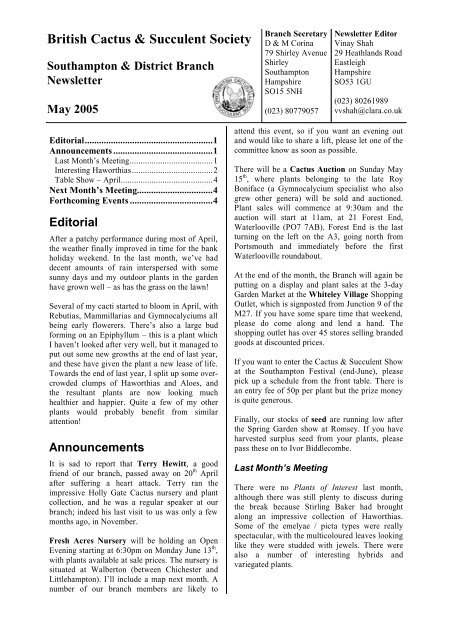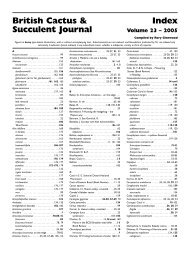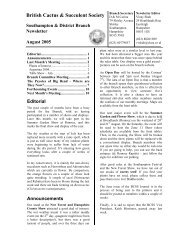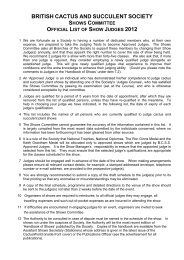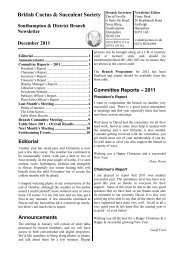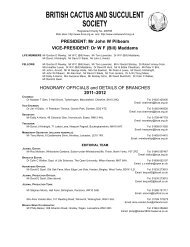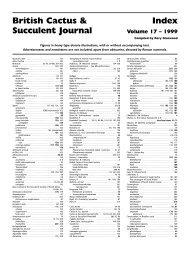British Cactus & Succulent Society - southampton.bcss.org.uk
British Cactus & Succulent Society - southampton.bcss.org.uk
British Cactus & Succulent Society - southampton.bcss.org.uk
Create successful ePaper yourself
Turn your PDF publications into a flip-book with our unique Google optimized e-Paper software.
BCSS Southampton & District Branch – May 2005 Newsletter Page 1<strong>British</strong> <strong>Cactus</strong> & <strong>Succulent</strong> <strong>Society</strong>Southampton & District BranchNewsletterMay 2005Branch SecretaryD & M Corina79 Shirley AvenueShirleySouthamptonHampshireSO15 5NH(023) 80779057Newsletter EditorVinay Shah29 Heathlands RoadEastleighHampshireSO53 1GU(023) 80261989vvshah@clara.co.<strong>uk</strong>Editorial......................................................1Announcements ..........................................1Last Month’s Meeting......................................1Interesting Haworthias.....................................2Table Show – April..........................................4Next Month’s Meeting................................4Forthcoming Events ...................................4EditorialAfter a patchy performance during most of April,the weather finally improved in time for the bankholiday weekend. In the last month, we’ve haddecent amounts of rain interspersed with somesunny days and my outdoor plants in the gardenhave grown well – as has the grass on the lawn!Several of my cacti started to bloom in April, withRebutias, Mammillarias and Gymnocalyciums allbeing early flowerers. There’s also a large budforming on an Epiphyllum – this is a plant whichI haven’t looked after very well, but it managed toput out some new growths at the end of last year,and these have given the plant a new lease of life.Towards the end of last year, I split up some overcrowdedclumps of Haworthias and Aloes, andthe resultant plants are now looking muchhealthier and happier. Quite a few of my otherplants would probably benefit from similarattention!AnnouncementsIt is sad to report that Terry Hewitt, a goodfriend of our branch, passed away on 20 th Aprilafter suffering a heart attack. Terry ran theimpressive Holly Gate <strong>Cactus</strong> nursery and plantcollection, and he was a regular speaker at ourbranch; indeed his last visit to us was only a fewmonths ago, in November.Fresh Acres Nursery will be holding an OpenEvening starting at 6:30pm on Monday June 13 th ,with plants available at sale prices. The nursery issituated at Walberton (between Chichester andLittlehampton). I’ll include a map next month. Anumber of our branch members are likely toattend this event, so if you want an evening outand would like to share a lift, please let one of thecommittee know as soon as possible.There will be a <strong>Cactus</strong> Auction on Sunday May15 th , where plants belonging to the late RoyBoniface (a Gymnocalycium specialist who alsogrew other genera) will be sold and auctioned.Plant sales will commence at 9:30am and theauction will start at 11am, at 21 Forest End,Waterlooville (PO7 7AB). Forest End is the lastturning on the left on the A3, going north fromPortsmouth and immediately before the firstWaterlooville roundabout.At the end of the month, the Branch will again beputting on a display and plant sales at the 3-dayGarden Market at the Whiteley Village ShoppingOutlet, which is signposted from Junction 9 of theM27. If you have some spare time that weekend,please do come along and lend a hand. Theshopping outlet has over 45 stores selling brandedgoods at discounted prices.If you want to enter the <strong>Cactus</strong> & <strong>Succulent</strong> Showat the Southampton Festival (end-June), pleasepick up a schedule from the front table. There isan entry fee of 50p per plant but the prize moneyis quite generous.Finally, our stocks of seed are running low afterthe Spring Garden show at Romsey. If you haveharvested surplus seed from your plants, pleasepass these on to Ivor Biddlecombe.Last Month’s MeetingThere were no Plants of Interest last month,although there was still plenty to discuss duringthe break because Stirling Baker had broughtalong an impressive collection of Haworthias.Some of the emelyae / picta types were reallyspectacular, with the multicoloured leaves lookinglike they were studded with jewels. There werealso a number of interesting hybrids andvariegated plants.
BCSS Southampton & District Branch – May 2005 Newsletter Page 2Thanks are due to David Corina for providing thefollowing write-up of last month’s talk by StirlingBaker.Interesting HaworthiasThis was a two-part programme featuring plantsin the first half and slides in the second. Stirlingopened his talk by quoting a definition of(Haworthia) species by Bruce Beyer [fromHaworthiad, the journal of the Haworthia society]which he, and most of the audience, foundincomprehensible! Bayer is probably the currentauthority on the genus, and his system ofnomenclature is generally accepted.There is considerable variation in Haworthias,plants of the same nominal species vary widelyover their range and this has led to a proliferationof names. [See postscript 1] Stirling had broughtalong ‘typical’ examples of plants that were‘accepted for the name’ as he put it. Not allHaworthia species were covered, only those thathe thought were worth growing. The plants werediscussed in ‘groups’ based on growth formsrather than the botanical divisions. As most ofthis text is discussing one genus, I shall imitateStirling and omit the ‘H.’ and just give the speciesnames in the account below.Probably most people in the audience had hopedfor lots of tips on how to grow Haworthias, butStirling did not spend much time on this topic.His basic tips were to grow in bright light (to getgood colours) but not full sun all day, and give asmuch air as possible – alpine house treatment!Most Haworthias tend to grow early in the year.Best to repot into one’s own compost, in a deeperpot where possible. This enables you to check theroots and remove any dead ones. Current wisdomstates that Haworthias ‘re-root’ every year. Therehas been much written about composts forHaworthias, and in the past a heavy soil-basedmix was advocated, but current ideas favour alighter mixture containing (expanded) pumice fordrainage, and even growing in the completelyartificial medium Seramis [see BCSS Journal19(3) 2001 p.158]. Suggested mode ofpropagation from seed was to sow about 10 seedson the top of seed compost in a 2" square pot,cover with a sprinkle of silver sand, water fromthe bottom with hot water and enclose the pot in apolythene bag. Keep the seedlings growing on inthe shade.Cuttings are not theoretically possible for thestemless species but it is possible to cut thecentres out of the plants and hope that newrosettes are formed from the stump. Plants cannotbe grafted. Many species will propagate fromleaves, and the stemmed species can have the topsre-rooted (hormone rooting powder and bottomheat recommended). Otherwise plants can besplit up into the offsets and started again – often agood idea for old plants.If you are a real enthusiast (or a masochist!), thenread on … …otherwise go to end!First plants out of the box were the group withsomewhat incurving, soft tufted leaves edged with‘bristles’, typified by arachnoidea, a variable,slow species; a good form of this is scabrispina.Although the leaves are soft, this group of plantscan withstand drought (by closing up the rosette)and strong light (the bristles filter the sun). Allare slow growers, usually solitary for theirlifespans with us! Other familiar species in thegroup are bolusii and its var. aranea, and var.palmiana(?) which looks like arachnoidea; thennortieri, difficult, keep cooler and out of the sun;and semiviva, an autumn grower. Next camemucronata and its var. morrisiae and the similarhabdomadis var. inconfluens. Lastly, the reallychoice species: lockwoodii needs no introductionbut Stirling reserved the term ‘gems’ for the smallsoft leaved species pulchella (the original form,very slow, 15 to 20 year old plant still in a 23/4in. pot), pubesens, archeri (now in withmarumiana) and archeri var. dimorpha.Although larger and easier to grow, cooperi andform venusta were included in this group. Withall of the above, there are many clones around andit is best to choose a good one. A general hint oncultivation was that if the rosette is tightly closed,give a drink, if open, do not!Probably the most popular group are the flatleavedretusae types, typically the emelyae-pictacomplex. There are lots of forms and varieties,e.g. emelyae var. major. Need to buy these “onsight” to get good forms. A clumping species ispygmaea and pygmaea var. argentea maculosa(but some are wrongly named, ‘splendens’ nowregarded as magnifica splendens); choose goodleaf markings. H. comptoniana is now regarded asa variety of emelyae and can grow quite large; itappreciates some shade. For mirabilis, the var.badia is the best, and var. buekmannii clumpswell but then falls to bits, so start again!Bayeri/uniondalensis is liable to burn if kept toosunny. Other popular species in this group aremaughnii (which can get quite big) and truncata,which really need no introduction, but others are
BCSS Southampton & District Branch – May 2005 Newsletter Page 3less common such as pygmaea (var. ‘Frosty Top’is nice) and springbokvlakensis (remaining small)and bruynsii. (The latter is still rare in collections– perhaps due to its high price, difficulty ofpropagation and slow growth; most plants offeredrecently are most likely to have beenmicropropagated.) Last in the group is tesselata, agood grower – there are some good small clonesand the cv. ‘Lady Gray’ is recommended.On to the ‘hard’ leaved ones. coarctata (esp. asmall form var. bellula) and reinwardtii arecommon, but some forms are difficult. Someplants of this group develop ‘stems’ which aresometimes spoilt by leaves part way up dyingback. Stirling said that the cause of this isunknown. Many of this group develop prettytubercles, often white and pearlescent, giving riseto good markings. One of the potentially tallestspecies is pumila, but minima belies its name andis certainly nowhere near being the smallestHaworthia. For minima, the var. ‘Bryan Makin’is a fine form. Slow and more choice are sordidaand its var. lavrani (possibly the same as sordidavar. agavoides) and scabra, but scabra var.morrisiae is easier.Haworthia is a genus that lends itself tohybridisation, but Stirling warned against any oldhybrid – they must have some merit to be retainedas many are not worth growing. Joyce Coccoza isamong those who produce many attractivehybrids, in addition to her excellent drawings ofHaworthias. The Japanese also produce manyfancy varieties. Many such crosses were shown:for example maughnii x badia (a good showplant), arachnoidea x truncata, (severalvariations) and herbacea x emelyae, perhaps thebest known of Joyce’s crosses.At the start of the second half, which was a slideprogramme, Stirling showed variegated forms ofmany of the species discussed earlier. [magnifica,venosa (unstable), limifolia (stable), cymbiformis,retusa, viscosa and maughnii. Here Stirlingsneaked in Gasteraloe x ‘Green Ice’, a veryattractive plant with possibly a variegatedGasteria batesiana somewhere in its lineage. Thefeeling here is that one either likes them or hatesthem! Some further hybrids were shown here,repeating some we had seen as plants in the firsthalf, plus pygmaea x paradoxa (often differentnames, same cross), comptoniana xspringbokvlakensis (reasonably quick growing),limifolia x striata (not easy) and correcta xspringbokvlakensis.Returning to ‘pure’ plants we heard that badia,with thick leaves, is difficult to get to ‘sit’ on thecompost, a miniature form of coarctata, one ofthe smallest rosettes with parksiana (slow, can bedifficult), pubescens (nice), habdomadis var.inconfluens keeps a tight rosette, maraisii (nowunder magnifica) and the lockwoodii trio referredto in the first half, and schuldtiana. Nice veiningis possible on correcta (although this tends to loseleaves and often pulls itself down into the soil).At this point Stirling gave the Haworthias a restwhen he showed a few slides of some othersucculents, the most exciting of which wasMuiria, followed by some Anacampseros andAvonia, Ariocarpus, Brachystelma, a Lithops anda lovely Crassula mesembryanthemopsis.Back to the evening’s main topic. We moved onto splendens x badia crosses, small plants, severalclones, will colour up well in good light but keepthe roots cool. Next, koelmaniorum and some ofits hybrids, pulchella var. globifera(?), semiviva(small and variable), mcmurtryi (some consider avar. of koelmaniorum), tesselata (various patterns,some good, some named) and others seen earlieras plants.Postscript 1. Hobbyists new to Haworthias neednot fret too much about identifying their plants.Although the taxonomy of Haworthia is thesubject of often acrimonious debate, it is mainlythe retusae types which cause problems; probablya good 60% of the species are fairly readilyidentifiable in the newer books, e.g. Bayer’s‘Haworthia Revisited’.Postscript 2. I apologise for breaking my ownrule that the scribe should not write a blow-byblowaccount of a talk. Perhaps that’s because Iam a Haworthia enthusiast! You have the optionto skip the ‘heavy’ bits. And I leave the flowerson my plants, although this is more throughlaziness than intention (unless I’m trying forseed).David Corina


